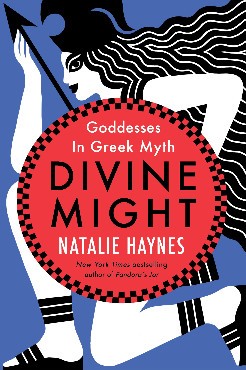WE ARE in a museum which is packed with exhibits but empty of visitors. Has it closed for the day, or are we here early? As we pick our way past sculptures of Athene and other gods and goddesses, daylight streams through a roundel in the roof of a gallery ahead of us. The darkness that surrounds us is banished from this bright column. It illuminates a single vase, a huge piece of black-figure terra-cotta. This shows one of the most popular scenes in Greek mythology: Hercules (Heracles, to give him his Greek name) in battle with the Nemean lion. The lion rears up on its back legs. Its jaws are open and one forepaw reaches out to claw at Hercules. The hero looks unconcerned, and his right arm is drawn back, ready to strike. His left hand reaches forward, mirroring the lion. Perhaps he is about to grab at the thick mane.
Above this image is a geometric black border, and above that, on the neck of the jar, is a second figurative image. Five Muses all wear similar but subtly different white robes, draping down from the shoulders, belted at the waist. Each has finely dressed hair: piled in curls atop her head, flowing in waves down her back, tied into a topknot. Five is an unusual number for Muses – according to the second-century geographer Pausanias, the earliest writers (now lost) claimed three Muses, then four. By the time of Hesiod in the eighth or perhaps seventh century BCE – and our earliest source – there were nine.
The Muses face us. We don’t know it yet, but later we’ll realize that they are Calliope, Muse of epic poetry; Clio, Muse of history; Thalia, Muse of comedy; Terpsichore, Muse of dance; Melpomene, Muse of tragedy. Clio holds a scroll to represent history, and Melpomene carries a tragedy mask. They may not be the first thing we see when we look at the vase, but they’re soon the only thing. Perhaps it’s a little reminder that the word museum means ‘home of the Muses’. They own this space, and we are their audience.
This is the opening sequence of Disney’s 1997 movie Hercules. The music begins to play, and the Muses do what has come naturally to them for millennia: they sing, and they dance. They act as the chorus of a comic play: they react to the plot as it occurs – most brilliantly as the backing singers in ‘I Won’t Say (I’m in Love)’, midway through the film. They also provide us with some backstory at the start. In this instance, it is the story of the Titanomachy: the war between the Olympian gods, led by Zeus, and the Titans, an earlier race of gods who rose up against them. Although Zeus proved triumphant, we soon discover that the Titans are waiting to be released from their subterranean prison to try again. Hades – god of the Underworld – is ready to orchestrate this attack, but a puny mortal stands in his way.
And so the stage is set for a hugely witty and sophisticated version of the Heracles story. Not only that, but the Muses have continued in a tradition which began in Hesiod’s poem the Theogony. This introduces us to the idea of a set of beautiful goddesses who tell us in song about the earliest gods. The Disney Muses do just the same thing: our story actually begins long before Hercules, many aeons ago, says Calliope, as they warm up that opening number. She’s about to tell us a pretty outlandish story. So can we take their word for it? Well, Hesiod certainly does in his poem. And we should too. Even if these Muses weren’t singing a gospel number, we would surely know they can be relied upon from the title of the song: ‘The Gospel Truth’.
